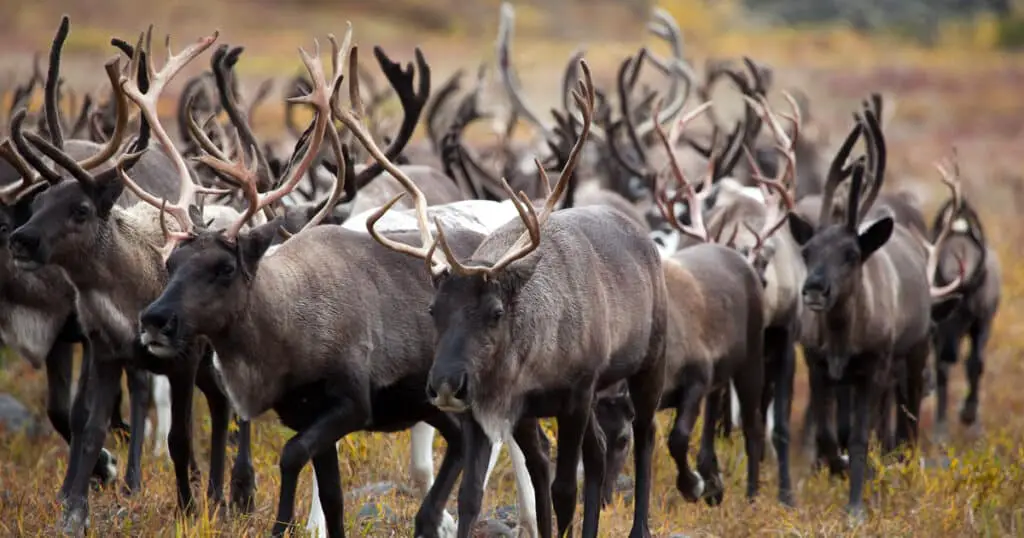Witnessing the caribou migration is one of the most breathtaking events for anyone interested in wildlife and nature. However, it’s a time sensitive event that involves multiple moving parts, so it can be difficult to see in person and in real time. But if you know where it occurs, when it takes place, and what to look out for, it can be a fascinating event. Keep reading to learn more about caribou migration.
The location and timing of the caribou migration depends on multiple factors, such as the caribou subspecies that’s migrating and the reason for the migration. As a result, there are multiple spots to get a good look at some caribou herds.
The following article is a detailed description of the where, when, why, and how of caribou migration, so it includes everything you need to know.
We’ll also briefly dive into the differences between caribou and reindeer, as well as touch on the history between caribou and Native peoples.
Caribou Migration Locations
The locations of where caribou migration starts and ends depend on the subspecies.
But usually, caribou migrate up north towards the mountains in fall and winter, and return to their fields along the coast in spring and summer.
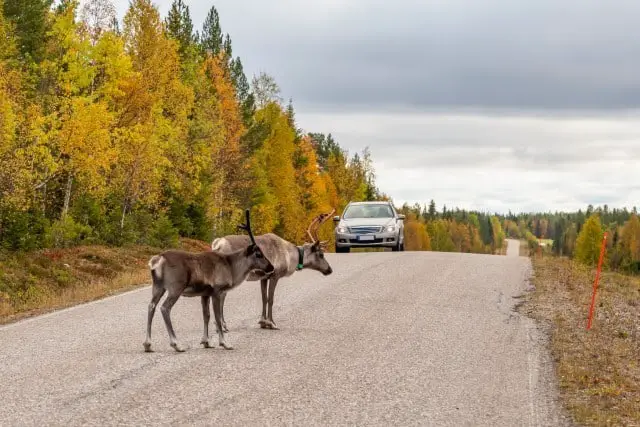
For example, the Porcupine subspecies of caribou begin their migratory cycle on the coasts of Alaska and Canada. They stay in what is referred to as their “natal grounds” through the warmer months.
Most caribou subspecies, including Porcupine, form large herds during this time of year since this is when they are the most social.
The large groups also give them some relief from the swarms of bugs that develop during the summer.
When fall starts rolling around, the caribou break off into smaller groups and start heading north towards the mountains and winter ranges.
They try to find patches of land that have little to no snow, so they can easily find and feed on lichen, their primary winter food source.
Since the fields are vast and barren, one can easily spot caribou digging for lichen with their hooves or running through the fields.
In general, a good place to start looking for caribou during the warmer months is along northern coastlines.
In the winter months, looking around mountains, wide and barren fields, and ridges is your best bet. However, looking for caribou will be a fruitless endeavor if you also don’t look for them at the right time.
When Does The Migration Happen?
Most caribou make their migration trek twice a year, once in the spring and once in the fall. The typical time period for caribou to migrate northwards starts in spring, usually around April.
The mating season usually comes to an end in October or November, and female caribou are ready to give birth to their offspring.
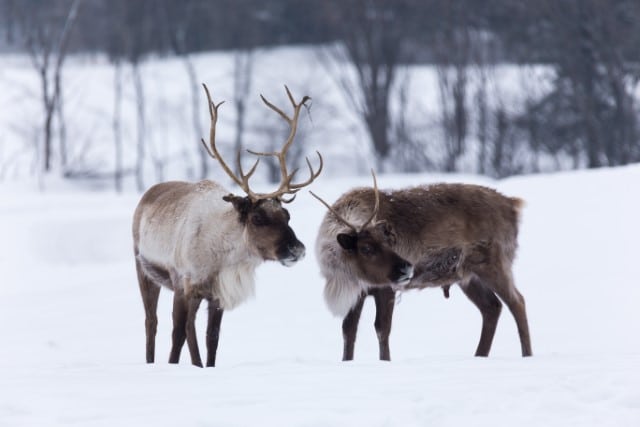
They need to be in a specific birthing field for this to happen, and each herd has one, with the exact location varying from species to species.
For example, the Porcupine herd’s birthing fields are on the Arctic Coastal Plain. But the fields can also be more towards the mountains or wintry ridges, depending on the subspecies and herd.
Sometimes, only the birthing females will go to the fields, while males and females that aren’t pregnant will stay along the outskirts as a form of protection until the second migration begins.
Caribou start to make the journey back around summer, usually late June or early July. They head further north this time around, towards areas where it’s too cold for mosquitoes and other bugs to survive.
They will only stay there for a few weeks. Once that time has passed, they will start heading back down south to the tundras and treeless fields where they started. And the cycle continues.
Caribou usually follow the exact same paths and go to the exact same locations during every migration cycle. Once you know where caribou are going and when, you’re able to arrange viewing them.
Why Do Caribou Migrate?
Caribou migrate for a variety of reasons, depending on what the herd needs at the moment. Food availability and needs are the most common reason that caribou migrate.
If there isn’t much food where they currently are, they will start to migrate somewhere else so that each member of the herd can be fed.
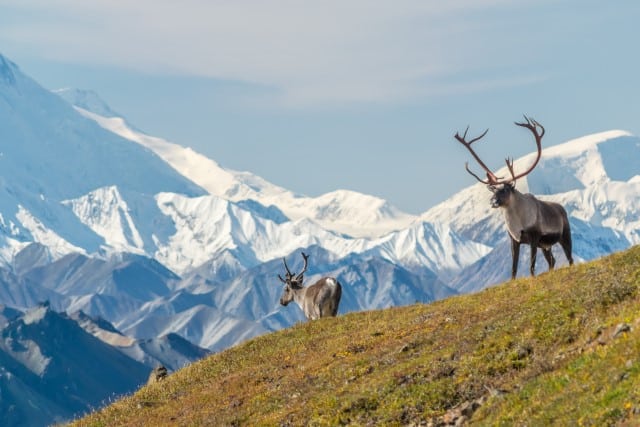
This need for food increases when female caribou start giving birth and the offspring begin to grow.
Female caribous need a significant amount of energy since they are lactating and raising their young, so they need more food.
Furthermore, when caribou young start growing, antler development and molting causes their appetites to increase ten fold.
To make sure the herd gets the energy they need, the caribou will migrate towards somewhere with plenty of food to feed them all.
Caribou might also migrate to avoid predators, especially after the birthing season. Baby caribou are extremely vulnerable to predators since they are small and weak.
Some common predators that prey on young caribou include:
- Wolves
- Grizzly bears
- Golden eagles
Caribou have thick coats of fur to help them survive the bitter cold of far northern areas, so they are able to migrate in that direction to get away from the above predators.
They also migrate in large groups with the vulnerable offspring and mothers near the center as a defense maneuver.
How Do Caribou Know When and Where to Migrate?
The answer to this question is still a bit up in the air, but animal behavioral scientists do have some theories.
The main theory is that caribou know when to migrate based on environmental and weather cues.
Decreasing temperatures and the first signs of snowfall were the main weather changes that caribou noticed and took as indicators that it’s time to migrate.
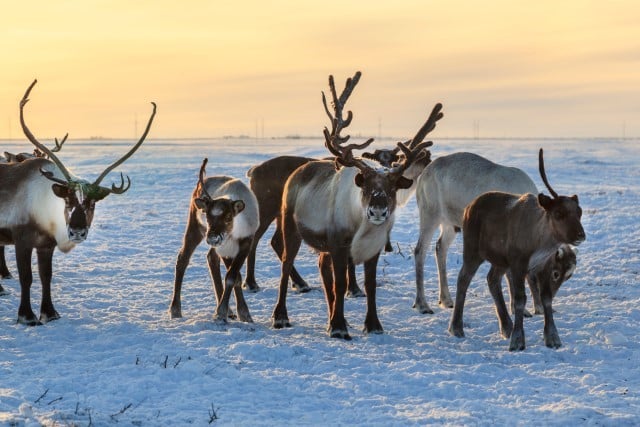
On the flip side, warmer temperatures and an abundance of mosquitoes and other bugs are also indicators to the caribou that it is time to move further north.
However, weather changes can vary, sometimes significantly, from year to year. So while this is a promising theory, it doesn’t fully confirm how caribou know when to migrate.
As for where caribou know where to migrate, the answer to this is simpler. For the most part, caribou follow the beaten paths that herds before them have left.
Caribou almost always follow the exact same migration paths each year.
Some herds also have leaders that guide the herd to migration locations each year.
Remarkably, the leadership role is passed down from generation to generation. Each new herd leader learns where to take the herd for each migratory cycle.
The World’s Largest Caribou Herds
Caribou migrations are the largest migratory events on the planet. Herds as large as 50,000 to even 500,000 caribou travel thousands of miles each year.
The Barren-Ground caribou herd is the largest migratory caribou herd in the world. They are primarily located in the Northwest areas of Canada, around the southern end of the Tuk Peninsula, to the United States border.
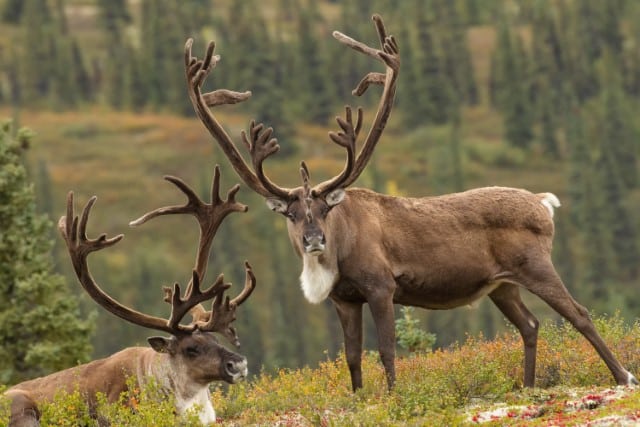
The herd has a total of 300,000 caribou, and the massive herd can easily be seen around migration times.
Another enormous herd is the Porcupine Herd that lives around the Porcupine River in Alaska. It has more than 170,000 caribou.
The Porcupine Herd’s migration route is even more impressive than its size. Its migration route is the longest in the world, spanning almost 1,500 miles long both ways.
The caribou of this herd walk the most of any animal on land in the world.
Differences Between Reindeer and Caribou
Put simply, there is no much difference between reindeer and caribou! The only differences are where they live and whether they migrate.
Reindeer are caribou that live in Europe. Unlike caribou in North America, Reindeer don’t migrate. They stay in the same place all year round. They also tend to be a little smaller.
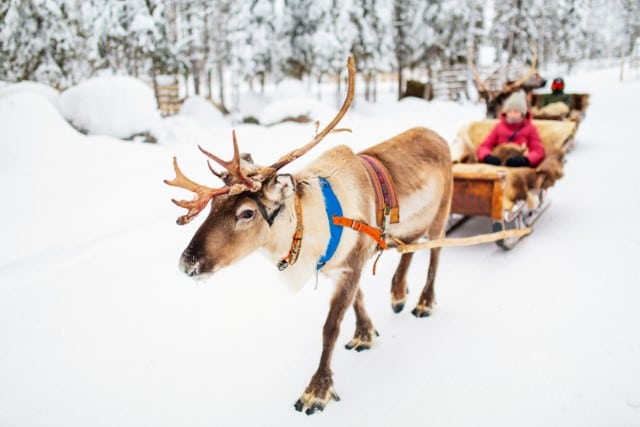
Caribou in Europe are called reindeer, whereas we call them caribou in North America.
The Reindeer’s no-migratory nature is heavily due to the domestication they received from humans in Europe.
Reindeer are still used as animals of burden and for their resources to this day, but there are still some wild reindeer in Europe.
Best Places to See Caribou
Alaska is the best place to see Caribou in North America.
The top three best areas to see caribou in Alaska are Denali National Park, Kenai Peninsula, and Glenn Highway near Eureka Summit.
Denali Park is the most famous caribou viewing spot on this list. Hikers and tourists regularly see caribou along the 92 mile long road.
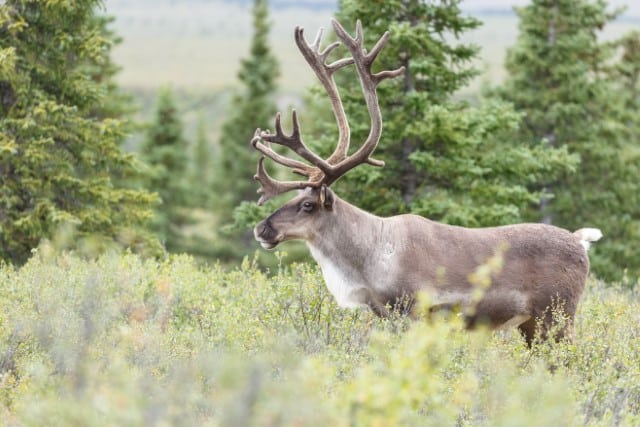
It’s best to head out deep into the park early in the morning. You’ll get there before the area gets too crowded.
Make sure to bring a pair of binoculars and watch the fields for any signs of movement.
The are more than 3,000 members in the caribou herd that frequents the area. There may also be brown bears and gray wolves in the area, so be careful.
Kenai Peninsula is another popular place to see caribou. You should know, though, that several small caribou herds (rather than one large one) are seen around here.
They are usually feeding in the marshy flats on both sides of Bridge Access Road, mostly between June and August.
Do you want to see a larger herd? You can head north towards the Kenai mountains for spectacular views of the landscape and the caribou.
Finally, caribou herds sometimes wander near Glenn Highway, a highway near the Eureka Summit. Drive slowly along the highway and keep a lookout for any movement.
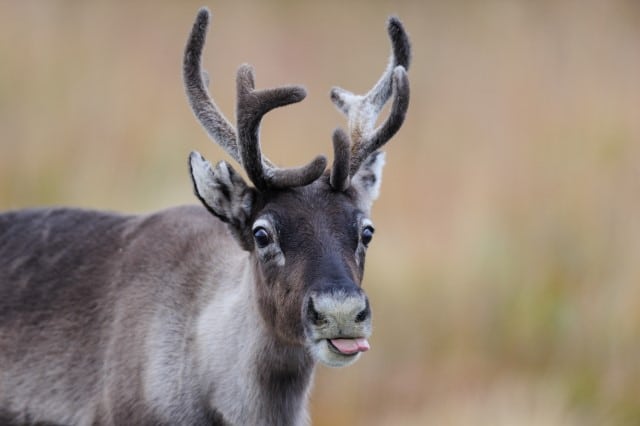
You’ll only be able to see the caribou from far away. Witnessing them in their natural habitat is well worth it.
The best time to go is during the summer months, since there isn’t as much human activity due to snowboarding or ATV riding.
In general, if you get the chance to travel to Alaska, keep an eye out for any caribou that might be wandering around.
Alaska is one of the main places they can be found, and witnessing them in the wild is an amazing sight.
Final Thoughts About Caribou Migration
Do you want to see caribou in migration one day? Now you have the information you need to start making some plans.
While caribou numbers are strong today, human activity and expansion has put some strain on this species. Fortunately, conservation efforts have been put in place and have helped the herds.

